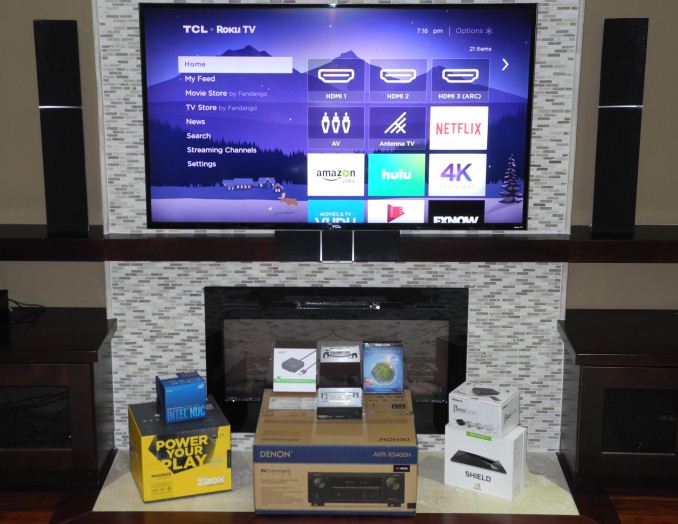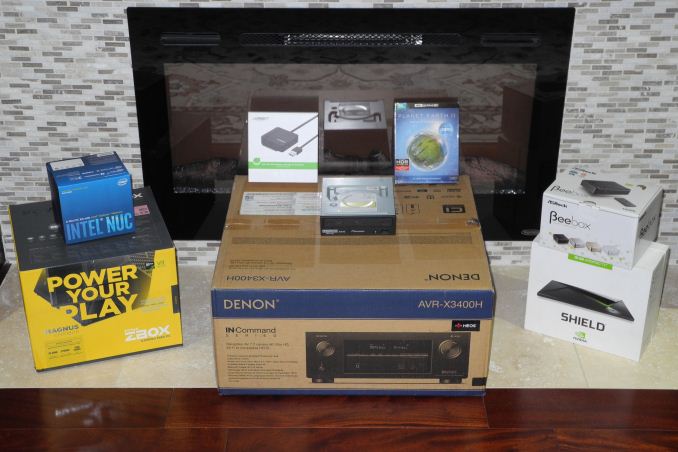A Budget Home Theater & PC Setup: 4K, HDR, UHD Blu-ray, and More
by Ganesh T S on December 26, 2017 8:30 AM EST
The days of bulky HTPCs with built-in optical drives, massive internal storage arrays, and integrated TV tuners are long gone. The advent of over the top (OTT) online streaming services has moved a lot of functionality to the cloud. As NAS units become more powerful, it has made sense to move local media files to a central repository. All these have enabled the TV-connected PC to become more compact. Unless the consumer has specific requirements (like, say, high quality gaming), even ultra-compact form factor (UCFF) machines such as the Intel NUCs can fit the bill.
Home Theater Components: Keeping up with the Times
The primary functionality of HTPCs has evolved to become one of a powerful and versatile media player. However, recent advances such as 4K and high dynamic range (HDR) videos, as well as stricter DRM requirements such as HDCP 2.2 for premium content have made the perfect HTPC platform difficult to achieve. Before delving deeper into these new advances, it is helpful to have some insight into how the landscape has changed over the last decade or so. The advancements in that timeframe have meant that next attractive home theater feature was always around the corner. In the initial days of 720p televisions and other home theater equipment, it was Full HD (1080p). As 1080p became widespread, it was HD audio bitstreaming. After that, 3D support was sought after. A brief lull ensued before the market started slowly getting ready for 4K.
Over the last year or so, we have seen the appearance of displays and audio/video receivers (AVRs) supporting HDMI 2.0 / HDCP 2.2 along with HDR / Dolby Vision. Despite the announcement of HDMI 2.1, I believe that we have reached a point where it is possible to purchase a relatively inexpensive home theater and HTPC configuration without worrying about it getting obsolete within the the next 3 to 5 years.
On the media side, OTT streaming services have become popular to the extent that Netflix and YouTube moved to offer 4K videos to consumers ahead of Blu-rays. Fortunately, many modern PCs are capable of 4K Netflix playback, though HDR is available only on a subset of those configurations. UHD Blu-ray playback support is available through CyberLink PowerDVD 17. However, the hardware requirements are a lot more specific compared to premium OTT services. UHD Blu-ray playback with HDR requires that the home theater components fulfill additional requirements.
Building a Home Theater on a Budget
I started work on this home theater piece back in June 2017. The aim was to present a setup (TV, AVR, and HTPC) with all the bells and whistles, yet light on the wallet. While the TV (TCL 55P607) and the AVR (Denon AVR X3400H) were easy to narrow down based on the feature requirements and budget, the PC side proved to be more challenging. Our core requirements (compact form factor, 4K Netflix support, and HDR capability) narrowed down the choices to a NVIDIA Pascal GPU-equipped PC or a Kaby Lake PC with HDCP 2.2 capabilities. UHD Blu-ray support further narrowed this down to certain Kaby Lake PCs with a HDMI 2.0 / HDCP 2.2 display output.
In the course of our evaluation, we found that consumer electronic (CE) equipment almost always received features ahead of HTPC platforms. Keeping this in mind, we ended up evaluating a number of options for the fulfillment of HTPC duties
- Roku Smart TV platform in the TCL 55P607
- NVIDIA SHIELD Android TV (SATV)
- Zotac ZBOX MAGNUS EN1080K
- ASRock Beebox-S 7200U
- Intel NUC7i7BNHX
Prior to looking at the performance of these options, it will be of interest to readers to delve deeper into our choice for the other home theater components. Earlier this year, I happened to embark on a house remodel, and I took that opportunity to revamp the HTPC test components used in our system reviews. Our choice of components is geared towards a typical family room (15' x 15') home theater.











191 Comments
View All Comments
Reflex - Tuesday, January 2, 2018 - link
You are not answering my question:If I play back content that is encoded in DD5.1, 7.1 or Atmos, will your equipment do the proper object placement so that I get a sound effect in the appropriate location?
It is an important detail, if you cannot do that with the material that is available today, your solution is a solution for an audience of one. If it can do that, I am curious how it accomplishes it with what you are describing as essentially a 3.1 setup and with no Dolby or DTS license.
Bullwinkle-J-Moose - Tuesday, January 2, 2018 - link
"what you are describing as essentially a 3.1 setup and with no Dolby or DTS license."-----------------------------------------------------------------------------------------------------------------
The original reference design was 3.0
Moving the Bass speaker to a separate sub cab and calling it a 3.1 system makes zero sense
No Dolby or DTS License is correct
I do not support fake standards forged from a Real Standard
If Dolby and DTS is as good as mine, they should get a License from me
If you wish to play incompatible standards, be my guest
As I have said, I do not support Lesser Quality, incompatible or forged Standards
Dolby Vision is the same in that regard, as I or anyone else can easily create an "Open" Standard that is Visually the Equal of Dolby Vision without need for a Dolby License
Being locked into a proprietary and lesser Standard is "your" choice / not mine!
Reflex - Tuesday, January 2, 2018 - link
Then your setup is good only for you and content you produce, and for the purposes of the article and the discussion thread essentially meaningless. If you can't play back the content that is being produced accurately then it just isn't relevant to the discussion.I'm glad you enjoy your setup, I also enjoy mine.
Bullwinkle-J-Moose - Wednesday, January 3, 2018 - link
"Then your setup is good only for you and content you produce"------------------------------------------------------------------------------------
You are correct
I can produce content for anyone, and they can Lock it down with whichever proprietary standard they want for sale to people like you
My content can be encoded in the standard of the week or whatever "standard" Dolby comes out with next year
Yes, I wanted a system that can master for anyone!
and you want the finished result in a proprietary format of your choice
GOOD FOR YOU!
we are both happy with what we have!
Bullwinkle-J-Moose - Wednesday, January 3, 2018 - link
My Home Audio setups are for creating frontal 2 and 3 channel Audio ImageryI am not interested in surround but I could easily add as many surround channels as the next standard can handle
My focus is on audio production/mixing/mastering/Imaging
yet they are all I need or want for Video / Home Theater as well
All I really want is a great Audio Image in front, so I want what I have and I have what I want!
It's right for ME!
What works for you is also correct
There is no wrong standard here
You can believe in one standard, a hundred standards or none
wiyosaya - Friday, January 5, 2018 - link
I choose C: You are a troll!Aspernari - Tuesday, December 26, 2017 - link
Everything came out of your pocket, except several thousand dollars worth of stuff you recommended because you didn't have to pay for it, so it had no budgetary cost to you.Would you have really bought the $500 receiver instead of a suitable HDMI switch (if you didn't have enough HDMI ports for all your 4k sources) and using ARC or optical out from the TV with your existing receiver?
Your cost/benefit analysis is broken in this article. You keep trying to defend it, but it's not defensible.
ganeshts - Tuesday, December 26, 2017 - link
The $430 receiver was what I wanted in the build. That is what I was ready to spend my budget on.What part of the sentence 'pick and choose from the list' did you not get in the concluding section?
A HDMI switch will not do the job of the AVR.
It is not a matter of defensible or not - I have presented what worked and what didn't, even with the sponsored equipment. I have presented alternatives also. I think $349 for the AVR driving a $700 TV is a very reasonable budget - incidentally, the same amounts that I spent back in 2008 with a Toshiba Regza 46" TV and a Onkyo TX-SR606.
Aspernari - Tuesday, December 26, 2017 - link
Regarding not understanding: I understand just fine. Your choices are poorly considered and presented. I'll restate from elsewhere: You recommend readers buy $200 worth of Bluray-related hardware and deal with BSODs and/or pursue beta drivers, among other issues.Regarding the receiver: I guess you just wanted a new one, since a budget option would have been a TOSLINK cable or other solution to get audio from the TV to your existing receiver, abandoning the HDMI ports on it, and making use of an HDMI switch if you were short on HDMI ports. Total investment of about $40. Sure, you lose some of the functionality of the obsolete receiver (which you could still use fine on 1080p and lower content), but you also save $349 on sale/$430 retail/$464.40ish after tax by not buying a new receiver. Or getting someone to sponsor you.
" I have presented what worked and what didn't, even with the sponsored equipment." - You didn't present anything that I noticed that didn't work with the receiver. You state the inverse actually, "None of the issues encountered in the course of the evaluation presented in this piece could be attributed to the Denon AVR X3400H." - Which may well be true. But you also didn't evaluate the hardware you then recommend people go out and buy anyway, so the entire thing is moot. You're pushing hardware you didn't get your hands on, which just makes this all the more silly.
Imagine publishing a hardware review article, giving something a good "buy" recommendation,but never actually using the product. Oh wait - you just did that.
It's cool that you're going back and making edits based on the response here, but there's really two articles that should have written, crammed into this one:
1) A blog post about stuff you bought and the setup you made, where you can squeeze in your promotional consideration for Denon.
2) The testing you did and the issues you had navigating the current home theater market, focusing on 4k and HDR with HTPCs and high-end settop boxes.
Are you going to actually review the $1000 receiver, or is this article all that they're getting out of it?
edzieba - Tuesday, December 26, 2017 - link
"I guess you just wanted a new one, since a budget option would have been a TOSLINK cable or other solution to get audio from the TV to your existing receiver, "That's... not how things work. At all. Adding an S/PDIF cable is not going to magically allow transport of audio streams that:
a) Are too high bitrate for S/PDIF (which cannot even carry 5.1 LPCM)
b) Were developed decades after the S/PDIF standard
It's as ludicrous and nonsensical a suggestion as installing an IDE cable to allow your SATA motherboard to use m.2 PCIe NVME drives.